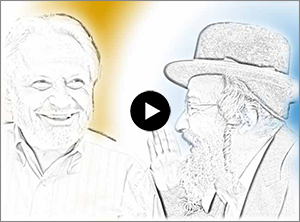Savran
Savran, or sometimes spelled Savaran, is a chassidic dynasty going back to the “Saba Kadisha” Rebbe Moshe Tzvi from Savran. I quote here from en.wikipedia.org:
Moshe Zvi of Savran
From Wikipedia, the free encyclopedia
Moshe Zvi Giterman of Savran (1775-1837), the Savraner Rebbe, was an influential Hasidic Rebbe in Ukraine whose following numbered in the thousands.
His father, Rabbi Shimon Shlomo (I), was the Maggid of Savran and a disciple of Dovber of Mezeritch, the primary disciple of the Baal Shem Tov, founder of Hasidic Judaism. Moshe Zvi was a disciple of his father, Rabbi Levi Yitschok of Berditchev and Rabbi Boruch of Mezhbizh. After his father’s death in 1802, Moshe Zvi took over his position as the Maggid of Savran. Moshe Zvi went on to become the Rabbi of Berditchev after the death of Rabbi Levi Yitzchok of Berditchev, and later became the Rabbi of the towns of Uman and Kishinev as well. He had thousands of chasidim in Volhynia and Bessarabia.
Moshe Zvi’s Torah insights were collected and printed in the book, Likutey Shoshanim. His son, Shimon Shlomo (II), succeeded him as Savraner Rebbe.
*****
Savran (Hasidic dynasty)
From Wikipedia, the free encyclopedia
Savran is the name of a Hasidic dynasty founded by Rebbe Moshe Zvi Giterman. Savran is a town in present-day Ukraine.
Lineage
Rebbe Moshe Zvi Giterman of Savran
Rebbe Shlomo Giterman of Savran – son of Rebbe Moshe Zvi
Rabbi Yisroel – son-in-law of Rebbe Moshe Zvi and nephew of the Kozhnitzer Magid
Rebbe Boruch Giterman of Savran – son of Rebbe Shlomo and son-in-law of Rebbe Dovid Hager of ZabaltovThe present Savraner rebbe is Rabbi Yisschar Dov Hager of Har Nof Jerusalem, he is a renowned Torah Scholar and serves (served) as the Av Bais Din on the Jerusalem Rabbinic Court. He is the son in law of Rabbi Avraham Leib Klein who served as the Mashgiach of the Rizhner Yeshiva in Jerusalem.
Torahs on the Parsha
The publishing arm of Mosdos Savran in Har Nof is Machon Ginzei Shoshanim. The Machon puts out on a weekly basis Torahs on the Parsha from Likutey Shoshanim from the Rebbe R. Moshe Tzvi, and from the current Rebbe, shlita, said over at Shalosh Seudos (mainly, and also at Kiddish and other events). The Torahs are available via email, if you are interested in receiving them, leave me a message on the contact form, or here in the comment box. They are translated into English by one of the kehilla who regularly comes to Savran in Har Nof. He prefers that I not mention his name.
I received permission from Machon Ginzei Shoshanim to publish the Torahs on my blog. I also received permission from the Machon to edit them if it seems to me correct. I plan to use this permission as follows:
Keyword Strategy — There are several key words that he spells differently that I would choose to. For example the translator spells the dynasty “Saverran”. Go Google “Rebbe Saverran” and see what you get. They don’t spell it that way online. I don’t mean this as a criticism, the opposite — I mean it apologetically to explain why I am changing things at all. The translator works lishma, and Kol HaKavod. But for me, for my expense in time, effort, and actual monetary outlay, I would like the Torahs to be seen, and here on my blog, not only lishma. As someone very close to me once said, and I paraphrase,”leave an old man to his folly.”
Slight editing — I looked through several many of the emails that I received from the Machon, and I see that in certain places here and there it requires slight editing, not much. It’s a hard job to do justice to translation from Lashon HaKodesh to English, unless you put it through a sieve seven times, or maybe seventy times, and I don’t know whether the translator has that kind of time or that kind of staff. I certainly don’t, but here and there I’ll perhaps do a light touch up work, like I did in the second wikipedia article quoted above.
Actual Content — the way I feel now, I am not planning at all in changing any of the content whatsoever. Even though I am present at Shalosh Seudos regularly at the Savraner Bais Medrash, and I have heard first hand most of the Torahs, still, I wouldn’t make a correction without checking it out first. I have already quoted one of the Admor’s Torahs in my son’s Bar Mitzvah drasha, and when I showed it to him first in order to double check it, he corrected me that I missed the point, so I don’t trust myself any more than the next guy. Still, if I am sure that there is an inaccuracy in the content, I will try to check it out in order to present it correctly.
Hashem should help that no mistake come out through my hand, and that the zchus of all the Tzaddikim should arouse Heavenly protection for us and our children, ad olam.





2 Comments
yaakov moshe nudelman
November 20, 2015Hi my family come’s from savran and my middle name is after my zady who was named after R’ Moshe Tzvi of Savran. In your article you said you could help me recieve the emails of the weekly torah’s of the savran rebbe in har ha-nof, i’d greatly appreciate it. I also would want to know how I could obtain the seforim printed by machon ginzei shoshamin, who sells them and how can you get them?
thanks a lot for your help.
Boruch Rappaport
November 20, 2015Shalom R. Yaakov Moshe,
It’s probably most efficient to get you directly in contact with the people involved. Just let me ask you two questions, 1) is the email that you left here on your comment, (which is of course not printed on my site), is that your actual email? and 2) can you communicate in Hebrew, that is, do you understand Hebrew and do you have the language pack on your computer in order to be able to write emails in Hebrew and to read the responses in Hebrew? If not, I will play the middle man and pass your emails back and forth.
A gitten erev Shabbos,
Boruch Rappaport
Leave A Response